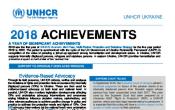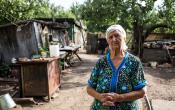Ukraine
For information on UNHCR’s operations in Ukraine prior to 2016, please visit the Regional Office in Ukraine page.
Operation: Ukraine
Location
{"longitude":31,"latitude":49,"zoom_level":5,"iso_codes":"'UKR'"}
By clicking on the icons on the map, additional information is displayed.
The boundaries and names shown and the designations used on this map do not imply official endorsement or acceptance by the United Nations.
Key Figures
| 2020 planning figures | |
| 75% | of IDP households are living in adequate dwellings |
| 25,000 | IDPs and 2,500 refugees and asylum-seekers receive legal assistance |
| 4,200 | IDPs will receive cash grants and 1,500 IDPs in-kind support |
| 500 | persons with undetermined nationality assisted with confirmation of nationality |
| 2018 year-end results | |
| 3,000 | people affected by conflict were reached through shelter interventions |
| 355 | refugees received livelihoods assistance |
| 148 | stateless persons were assisted in confirming their nationality |
| 18 | peaceful co-existence projects were implemented |
Latest Updates and Related Links
People of Concern
59%
Increase in
2019
2019
| 2019 | 2,454,245 |
| 2018 | 1,544,684 |
| 2017 | 1,844,785 |

[["Refugees",2172],["Asylum-seekers",2430],["IDPs",734000],["Returned refugees",1],["Stateless",35642],["Others of concern",1680000]]
Loading ...
Ukraine
< Back
2019
{"categories":[2015,2016,2017,2018,2019,2020],"budget":[null,42.25391395,37.63801174,31.0839244,27.78235177,29.75167645],"expenditure":[null,24.60120571,21.42935972,19.29978754,19.61200023,null]}
{"categories":[2015,2016,2017,2018,2019,2020],"p1":[null,7.1968692,6.77442765,6.02906483,4.65644531,5.40589061],"p2":[null,0.66575082,0.63256648,0.81396305,0.91078324,0.90883773],"p3":[null,null,null,null,null,null],"p4":[null,34.39129393,30.23101761,24.24089652,22.21512322,23.43694811]}
{"categories":[2015,2016,2017,2018,2019,2020],"p1":[null,5.4217403,4.82198014,4.39828383,3.92741683,null],"p2":[null,0.0711454,0.31401169,0.45969128,0.55133867,null],"p3":[null,null,null,null,null,null],"p4":[null,19.10832001,16.29336789,14.44181243,15.13324473,null]}
Loading ...
CHOOSE A YEAR
- 2016
- 2017
- 2018
- 2019
- 2020
Operational Environment
Since early 2015, with the adoption of the Minsk Agreement, Ukraine has had a partial ceasefire along a 457 kilometer long line of contact running through Donetsk and Luhansk oblasts in eastern Ukraine. However, violations of the ceasefire occur daily, and the negotiations among parties to the conflict have reached a stalemate. In the first half of 2018, civilian casualties and house destruction have decreased compared to 2017 but tensions remain high.As of 1 July 2018, more than 1.5 million people were registered by the Government as internally displaced. UNHCR’s intervention is part of an inter-agency effort and focuses on four main objectives which are the promotion of: adequate housing for IDPs; social cohesion; legal protection for IDPs to reduce or eliminate various administrative barriers that impact their rights; and community mobilization.
In its 2018-2022 multi-year and multi-partner strategy, UNHCR will adapt its interventions in three distinct operational contexts:
- to provide support to and protection monitoring of people living 20km on both sides of line of contact and provide emergency shelter/NFIs;
- to maintain UNHCR’s humanitarian assistance in non-government controlled areas (NGCA) and facilitate protection of rights;
- to work with partners on durable solutions for IDPs, linking to the growing humanitarian and development nexus in the rest of Ukraine.
Since no major new displacement is expected in 2019, the number of IDPs and IDP-returnees is expected to slightly decrease throughout the year. Many residents in the non-government-controlled areas (NGCA) will continue to travel frequently to government-controlled areas for family reasons and to access pensions and social services.
As of 1 July 2018, Ukraine hosted some 3,200 refugees and some 6,300 asylum-seekers. The majority of them originated from Afghanistan and the Syrian Arab Republic, with more than 50 other countries of origin also represented. In 2019, UNHCR will continue to work with the Government to bring the national asylum system in line with international standards, with a focus on local integration and self-reliance of refugees. Some important legislative initiatives aimed at strengthening the asylum system have been recently adopted, such as providing the same level of rights to unaccompanied children as to Ukrainian orphans.
As of 1 July 2018, UNHCR estimated that more than 35,000 persons in Ukraine are stateless. In 2019, UNHCR will continue to advocate for establishing and implementing an administrative procedure for birth registration that is flexible and responsive to the circumstances of families living in NGCA. This would entail simplifying the documentation requirements, offering registration services close to the line of contact and disseminating information about the administrative procedure. In addition, UNHCR will provide legal assistance to persons at risk of statelessness and advocate for the Government’s establishment of a statelessness determination procedure.
Key Priorities
In 2019, UNHCR will focus on:- leading the protection cluster and its different working groups, and fostering partnerships with IDP communities, international organizations, civil society, and central and local governments;
- protection advocacy, legal assistance, individual protection assistance (using a cash-based interventions where possible), community-based protection activities, such as peaceful coexistence projects and community support initiatives;
- protection monitoring that will largely focus on areas adjacent to the line of contact, but will also encompass areas with large IDP populations;
- conducting shelter repairs for vulnerable families whose house was damaged by the conflict, and responding to any flare-ups in the conflict with the delivery of essential NFIs;
- providing free legal aid to refugees and asylum-seekers regarding the asylum procedure, exercise of civil, social and economic rights, as well as access to public services;
- enhancing practices and strategy in the area of asylum litigation to ensure that judicial review becomes a stronger tool in removing gaps in the asylum procedure; and
- providing training on statelessness to the State Migration Service (SMS), Civil Registration Offices, judges, local administrations, Free Legal Aid Centers and NGOs, as well as legal counselling to stateless persons on obtaining documentation and access to statelessness documents or nationality.
























